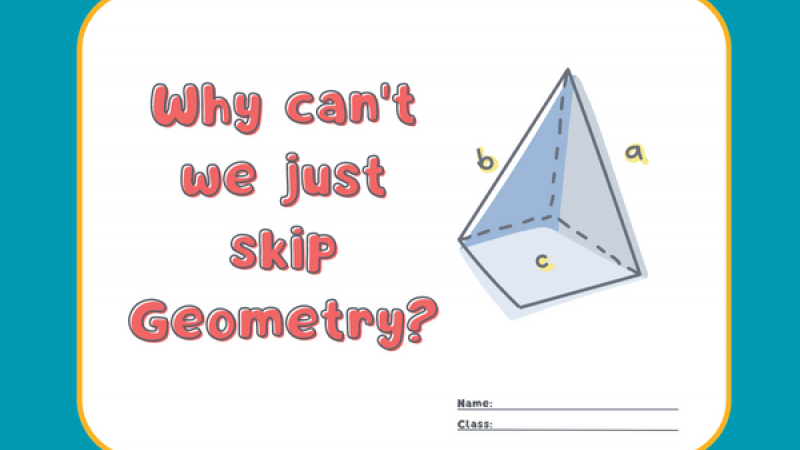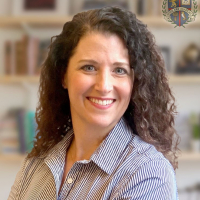Can We Skip Geometry?

One afternoon several years ago, I was sitting in my office (likely grading papers), when I received a phone call from my dad. He needed help figuring out how much cement to order for the fire station that his neighborhood volunteer fire department was building. Now, my dad is no dummy, but the calculations were getting complex and this was an expensive cement order, so he wanted to go through the numbers with me. You may know that cement is purchased by the “cubic yard” and frankly, that’s a tough unit to work with. (Side note: in writing this, I learned that a fully-loaded cement mixer truck carries up to 10 cubic yards and weighs up to 40,000 pounds!) So, my father thought it prudent to check in with the math teacher of the family to make sure he was doing all his calculations and conversions correctly.
This is just one example of how we use geometry in everyday life. The problem with which my dad called me is literally a geometry problem involving volume. But honestly, this isn’t even the first example I would give as a reason why your child should not skip geometry. Geometry is the classical educator’s dream subject. We actually have source texts for Geometry (Euclid’s Elements)! Geometry is classical, practical, logical, and beautiful, all wrapped up in a tidy package.
Euclid wrote The Elements around 300 BC, and it forms the basis of our study of geometry in the modern day. Far more than just a book of lines and shapes, Euclid systematically forms logical arguments based on previous theorems and postulates. Every step is justified using previously accepted reasoning, allowing a full system of logic to grow from a few initially assumed principles. This truly is an example of how we move from the “known” to the “unknown” in classical education. Until medieval times, geometry was actually considered one leg of the Quadrivium, which, coupled with the Trivium, formed the seven liberal arts. Geometry really isn’t optional when seeking a classical education for your child.
The practical applications of geometry are easier to see than probably any other upper-level math, notably in construction and home improvement! Measuring for flooring or new countertops, or decking materials will put your geometry skills to the test, but if you can DIY it, you’ll save money!
If you’ve ever heard the phrase “the shortest distance between two points …” or “as the crow flies,” you’re hearing a reference to the hypotenuse of a right triangle. Because most cities are laid out in a grid pattern, the long way (by street) is often the legs of a right triangle, while the short way (“as the crow flies”) is the hypotenuse.
I truly believe, though, that the most important skill students learn in geometry is in writing proofs. Developing a solid argument based on agreed-upon facts, students learn to take their “reader” from point A to point B (or from the known to the unknown) logically and systematically. They are required to provide proof (or “evidence”) for every statement they make, and it must be based on one of six things: a postulate, theorem, corollary, or definition that we’ve previously learned, given information, or a mathematical operation (algebra). In doing so, students are learning how to document their processes and validate their results, which is a life skill that will be put to work in almost any professional setting.
As a math teacher, I find satisfaction and beauty in all math, but it’s easiest to visualize in geometry.
When a student makes the connection between the regular polyhedra and the five different-sided dice that you might find in a Dungeons and Dragons game, that’s a beautiful thing!
When they stretch their brains to understand what happens when we take geometry out of a flat plane and put it on … a sphere, they are growing connections in their brain that weren’t there before.
Geometry and the art of M.C. Escher? Mind-blowingly beautiful if you can wrap your head around it! Students make connections with philosophy, chemistry, art, and more when they study geometry.
All this leads me to address the temptation to skip geometry. Every year, I hear of families choosing to skip the formal study of geometry and move straight from Algebra I to Algebra II. I would urge you to be cautious of this approach. Many of our Algebra I students are young (7th grade). Taking a year to study geometry gives their brain time to grow and mature before tackling the rigors of Algebra II.
Further, if your child is in our Jacobs Algebra I class, they benefit from continuing with another Jacobs book when they take Jacobs Geometry. Algebra review is built-in to the end of the first twelve chapters to keep them fresh on the algebra skills they will need to apply as the geometry becomes more and more algebra-based through the year, and this also helps position them for success in Algebra II.
If your child is in our Saxon live classes, note that Saxon parents have been told on various forums for years that geometry is built-in to the curriculum and a separate geometry class is unnecessary. While this may have been (somewhat) true with older editions of Saxon, with the 4th edition, which VSA teaches, this is absolutely not true. Geometry is a separate, stand-alone course that would be a gross oversight to neglect. Even if you are using an “older” version of Saxon, the integrated geometry is not proof-based, so you still need to supplement it with an outside geometry course.
Our Math-U-See students also have a progression of Algebra I to Geometry to Algebra II in their curriculum. Regardless of the curriculum path you’ve chosen for your child, the study of geometry is integral and should not be omitted.
It is a privilege to guide our students in exploring how God made things the way He did. Why are honeycombs hexagonal versus pentagonal? Why are we drawn to symmetry? These are philosophical questions, and we hope to point our kids directly to the mind of their Creator as they are looking for answers. The study of Geometry often requires mental gymnastics - and it’s not easy! When the Egyptian ruler Ptolemy asked whether geometry could be made easier, Euclid himself was said to have replied, “There is no royal road to geometry.”
Rather than looking to the easy way, consider giving your child a gift that they will benefit from for years to come in the form of a formal geometry course.







